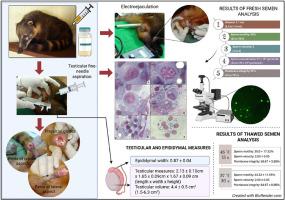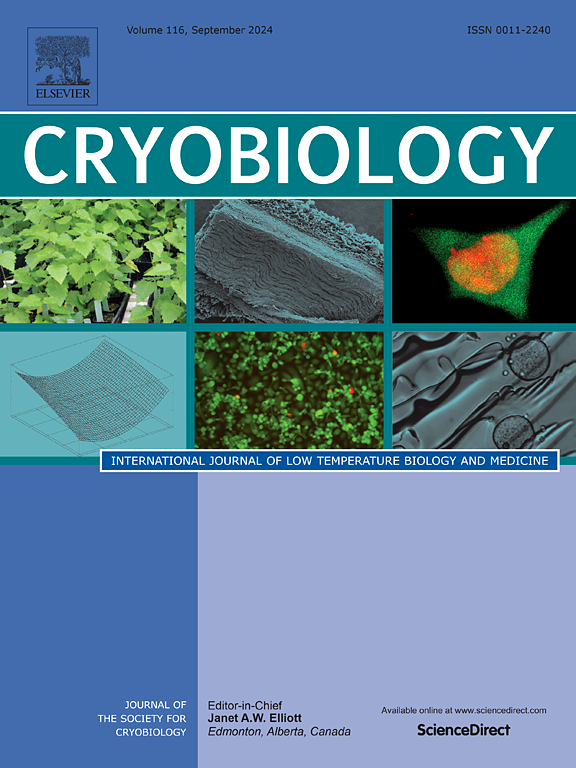Frozen sperm viability and seminiferous epithelium cytology of the coati (Nasua nasua)
IF 2.1
3区 生物学
Q2 BIOLOGY
引用次数: 0
Abstract
This study aimed to describe the cells of the seminiferous epithelium collected by fine needle aspiration cytology (FNAC), reproductive tract observations, semen collection, and sperm cryopreservation from coatis (Nasua nasua). Seven adult coatis were anesthetized, the reproductive tract was examined, and semen was collected by electroejaculation and cryopreserved using an extender based on protocol for domestic dogs, except that prior to cryopreservation, no centrifugation to remove the seminal plasma was performed. Testicular FNAC was also performed on each testis. The germ cells of seminiferous epithelium were identified and had cell characteristics similar to other species except for the secondary spermatocyte which was not present. Semen samples were collected from four animals, three of which were suitable for cryopreservation, although their seminal characteristics slightly declined after freezing. Examination of the coati reproductive tract revealed well developed penile bone and preputial glands like other carnivores. The testicular length x width x height meant 2.13 × 1.7 × 1.7 cm and testicular volume meant 4.5 cm3. The sperm morphology of coati exhibited an angular head shape, which was evident in the membrane integrity fluorescence assessment. The sperm motility was between 20 and 70 %, and the concentration was between 14 and 129 × 106 sperm/mL with motility of 30.0 ± 17.32 % vs 23.33 ± 11.55 % between samples thawed at 46 °C/15s and 37 °C/30s. In conclusion, testicular FNAC can be a useful tool for evaluating testicular function based on sperm production. Our findings demonstrate that semen collection and cryopreservation in coatis can be achieved using electroejaculation, extenders, and cryopreservation protocols similar to those used for domestic dogs. While these results provide a template for semen cryopreservation in other Procyonidae species, further investigation is needed to determine the necessity of removing seminal plasma.

长鼻浣熊冷冻精子活力及精母细胞细胞学研究
本研究旨在描述通过细针穿刺细胞学(FNAC)、生殖道观察、精液采集和精子冷冻保存收集的浣熊(Nasua Nasua)精系上皮细胞。对7只成年长鼻浣熊进行麻醉,检查生殖道,采用电射精法采集精液,并按照家犬方案使用延长器冷冻保存,冷冻保存前不进行离心取精浆。同时对每个睾丸进行FNAC检查。除次级精母细胞不存在外,其精上皮生殖细胞具有与其他物种相似的细胞特征。收集了4只动物的精液样本,其中3只适合冷冻保存,尽管它们的精液特征在冷冻后略有下降。对浣熊生殖道的检查显示,与其他食肉动物一样,它的阴茎骨和包皮腺发育良好。睾丸长×宽×高2.13 × 1.7 × 1.7 cm,睾丸体积4.5 cm3。长鼻浣熊精子形态呈角状头形,这在膜完整性荧光评价中表现得很明显。在46°C/15s和37°C/30s解冻时,精子活力为20 ~ 70%,浓度为14 ~ 129 × 106 /mL,活力为30.0±17.32%和23.33±11.55%。综上所述,睾丸FNAC可作为基于精子数量评价睾丸功能的有效工具。我们的研究结果表明,使用电射精、延长器和类似于家养狗的冷冻保存方案,可以实现长鼻浣熊的精液收集和冷冻保存。虽然这些结果为其他原卵科物种的精液冷冻保存提供了模板,但需要进一步研究以确定去除精浆的必要性。
本文章由计算机程序翻译,如有差异,请以英文原文为准。
求助全文
约1分钟内获得全文
求助全文
来源期刊

Cryobiology
生物-生理学
CiteScore
5.40
自引率
7.40%
发文量
71
审稿时长
56 days
期刊介绍:
Cryobiology: International Journal of Low Temperature Biology and Medicine publishes research articles on all aspects of low temperature biology and medicine.
Research Areas include:
• Cryoprotective additives and their pharmacological actions
• Cryosurgery
• Freeze-drying
• Freezing
• Frost hardiness in plants
• Hibernation
• Hypothermia
• Medical applications of reduced temperature
• Perfusion of organs
• All pertinent methodologies
Cryobiology is the official journal of the Society for Cryobiology.
 求助内容:
求助内容: 应助结果提醒方式:
应助结果提醒方式:


